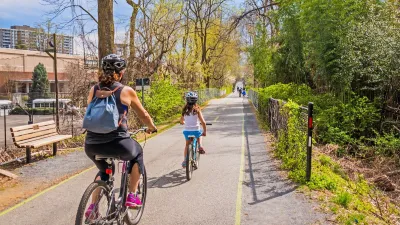After the federal government set maximum highway speed limits at 55 miles per hour, states spent decades undermining the rule.

Street safety advocates are calling for a return to enforcement of the 1974 National Maximum Speed Limit law, which limited highway speed limits to 55 miles per hour nationwide.
This rule, explains Aaron Short in an article in Streetsblog USA, was “slowly undermined” by states over the next several decades. “Today, though, advocates are making progress to claw back those gains — aided, unfortunately, by reckless drivers who killed 7,500 pedestrians in 2022, a 40-year high.”
The law was part of the Emergency Highway Energy Conservation Act, a response to the oil crisis which “required states to cap speeds on divided freeways with four or more lanes in order for states to receive federal highway funds.” As a result, 29 states lowered their speed limits.
The policy, designed to save gas, had unintended safety effects: “For a brief period in the mid-1970s, fewer people died on the roads. In the first year of the policy’s enactment alone, the number of fatalities fell by 16 percent, from 55,511 in 1973 to 46,402 in 1974, according to a National Research Council report conducted in 1984.”
Pressure from states led the federal government to loosen the policy in the 1980s, eventually rescinding it altogether in the 1990s. According to Short, “The changes may have had a catastrophic effect on the country’s health and safety, with a 3.2-percent increase in road fatalities between 1995 and 2005 that public health experts say accounted for 12,545 deaths that might not have occurred otherwise during that period.” Now, road safety advocates point to rising road deaths as a signal that lower speed limits, among other tools, are urgently needed to stem the traffic violence crisis.
FULL STORY: 50 Years Since Nixon’s ‘National Speed Limit’: A Tale of Missed Opportunities

Alabama: Trump Terminates Settlements for Black Communities Harmed By Raw Sewage
Trump deemed the landmark civil rights agreement “illegal DEI and environmental justice policy.”

Planetizen Federal Action Tracker
A weekly monitor of how Trump’s orders and actions are impacting planners and planning in America.

The 120 Year Old Tiny Home Villages That Sheltered San Francisco’s Earthquake Refugees
More than a century ago, San Francisco mobilized to house thousands of residents displaced by the 1906 earthquake. Could their strategy offer a model for the present?

In Both Crashes and Crime, Public Transportation is Far Safer than Driving
Contrary to popular assumptions, public transportation has far lower crash and crime rates than automobile travel. For safer communities, improve and encourage transit travel.

Report: Zoning Reforms Should Complement Nashville’s Ambitious Transit Plan
Without reform, restrictive zoning codes will limit the impact of the city’s planned transit expansion and could exclude some of the residents who depend on transit the most.

Judge Orders Release of Frozen IRA, IIJA Funding
The decision is a victory for environmental groups who charged that freezing funds for critical infrastructure and disaster response programs caused “real and irreparable harm” to communities.
Urban Design for Planners 1: Software Tools
This six-course series explores essential urban design concepts using open source software and equips planners with the tools they need to participate fully in the urban design process.
Planning for Universal Design
Learn the tools for implementing Universal Design in planning regulations.
Clanton & Associates, Inc.
Jessamine County Fiscal Court
Institute for Housing and Urban Development Studies (IHS)
City of Grandview
Harvard GSD Executive Education
Toledo-Lucas County Plan Commissions
Salt Lake City
NYU Wagner Graduate School of Public Service





























